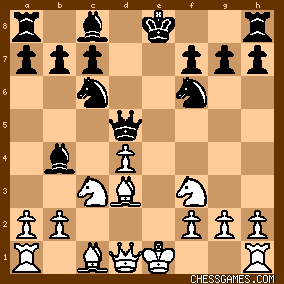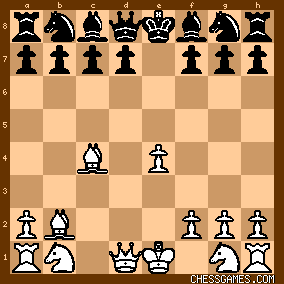|
= = = early deviations = = =
<1.e4 e5 2.d4 exd4 3.c3 -> 
click for larger view
Opening Explorer (428 games) Main Line: 1. e4 e5 2. d4 exd4 3. c3 d5 4. exd5 Nf6 5. Nf3 Qxd5 6. cxd4 Bb4+ 7. Nc3 Nc6 8. Be2

click for larger view
Opening Explorer (72 games) 1. e4 e5 2. d4 exd4 3. c3 d5 4. exd5 Nf6 5. Nf3 Qxd5 6. cxd4 Bb4+ 7. Nc3 Nc6 8. Bd3 
click for larger view
Opening Explorer (6 games) = = = a sort of G Ö R I N G _ G A M B I T = = =
<1.e4 e5 2.d4 exd4 3.c3 dxc3 4.Nxc3

click for larger view
Opening Explorer (31 games) Wikipedia article: Scotch Game#G%C3%B6ring Gambit = = = D A N I S H _ G A M B I T declined = = =
<<1.e4 e5 2.d4 exd4 3.c3 dxc3 4.Bc4 -cxb2

click for larger view
Opening Explorer (86 games) = = = D A N I S H _ G A M B I T accepted = = =
<<<1.e4 e5 2.d4 exd4 3.c3 dxc3 4.Bc4 cxb2 5.Bxb2

click for larger view
Opening Explorer (109 games) >>>>>> = = = C E N T E R _ G A M E = = =
<1.e4 e5 2.d4 exd4 3.Qxd4 Nc6 
click for larger view
Opening Explorer <4.Qe3 
click for larger view
Opening Explorer (557 games) <ever wondered why not 4.Qa4, which is a Scandinavian reversed with 4...e5? 
click for larger view
Opening Explorer (23 games) <(or 4.Qd3) 
click for larger view Opening Explorer (4 games only)
>>>>
Other collections: Game Collection: C22: Partita del Centro (3.Qxd4) ; Game Collection: 0 ;
Game Collection: center game ; = = =
Center Game (C22) = = = =
Event "Sussex-West Yorkshire"
Site "corr"
Date "1894.??.??"
White "Wright, Roger J rev"
Black "Shaw, William"
Result "1-0"
ECO "C22"
EventType "team (corr)"
1. e4 e5 2. d4 exd4 3. Qxd4 Nc6 4. Qd3 d6 5. Nc3 Nf6 6. Bg5 Be7 7. Be2 Bd7 8. O-O-O Ne5 9. Qg3 h6 10. Bxf6 Bxf6 11. f4 Ng6 12. Kb1 Bc6 13. Nh3 Qe7 14. Nd5 Bxd5 15. exd5 O-O 16. Bd3 Kh7 17. Rhe1 Qd7 18. Nf2 Rae8 19. Ne4 Bd8 20. Rf1 f5 21. Qh3 Kg8 22. Nc3 a6 23. Ne2 Ne7 24. Nd4 Kh8 25. c3 Nxd5 26. Bxf5 Qe7 27. Rd3 Qh4 28. Ne6 1-0 Wikipedia article: Nordisches Gambit
= = = = = = = = = = = = = = = = = = = = = = = = = = = = = =
= = = = = = = = = = = = = = = = = = = = = = = = = = = = = = The Scotch Game, or Scotch Opening, is a chess opening that begins with the moves: 1. e4 e5
2. Nf3 Nc6
3. d4
2.2 Scotch Gambit: 4.Bc4
2.3 Göring Gambit: 4.c3
2.3.1 4...d5
2.3.2 Other ways of declining
2.3.3 One-pawn gambit: 4...dxc3 5.Nxc3
2.3.4 Double-pawn gambit: 4...dxc3 5.Bc4
3 See also
4 References
5 Further reading
6 External links
Scotch Gambit: 4.Bc4
Scotch Gambit: 4.Bc4
Instead of 4.Nxd4, White has two ways to offer a gambit. The Scotch Gambit (which is the line recommended by GM Lev Alburt in his book Chess Openings for White, Explained) starts with 4.Bc4. Black can transpose into the Two Knights Defense with 4...Nf6 or he can continue the Scotch with 4...Bc5 5.c3 and now 5...Nf6 will transpose into a safe variation of the Giuoco Piano. Black can instead accept the gambit with 5...dxc3 but this is riskier because White will gain a lead in development, after 6. Bxf7+ Kxf7 7. Qd5+ and Qxc5. Göring Gambit: 4.c3
The Göring Gambit is a relative of the Danish Gambit that starts with 4.c3. White sacrifices one or two pawns in return for a lead in development, and typically follows up by putting pressure on f7 with Bc4, Qb3 and sometimes Ng5, while Nc3-d5 is another common motif. The Oxford Companion to Chess notes that the gambit was first played at high levels by Howard Staunton in the 1840s, and the earliest game with it was probably played in 1843.5 The first game with the gambit accepted may be Meek vs Morphy, New York 1857.6 Carl Theodor Göring introduced it into master play in 1872, but while Göring's name is most often associated with the one-pawn gambit (5.Nxc3) Göring invariably used the double-pawn gambit with 5.Bc4. The gambit has been played by Ljubomir Ljubojević, David Bronstein, Frank Marshall, and Jonathan Penrose. In casual games Alexander Alekhine often transposed to it via the move order 1.e4 e5 2.d4 exd4 3.c3 dxc3 4.Nxc3, when ...Nc6 for Black and Nf3 for White often followed. In general, the opening is unpopular at master level but is more popular at club level. It is recommended to study the Göring Gambit in connection with the Danish. 4...d5
Black can equalise by transposing to the Danish declined with 4...d5, when the critical line runs 5.exd5 Qxd5 6.cxd4 Bg4 7.Be2 Bb4+ 8.Nc3 Bxf3 9.Bxf3 Qc4 (or 6...Bb4+ 7.Nc3 Bg4 8.Be2 Bxf3 9.Bxf3 Qc4, leading to the same position), often referred to as the Capablanca Variation in view of the strength of Black's concept in the game Marshall-Capablanca, Lake Hopatcong 1926.7 This line (which can also arise from the Chigorin Defense to the Queen's Gambit),8 forcing White to either exchange queens or forgo the right to castle with the risky 10.Be3, deters many players from employing this gambit. Equal endgames result after either 10.Qb3 Qxb3 11.axb3 Nge7 or 10.Bxc6+ bxc6 11.Qe2+ Qxe2+ 12.Kxe2 Ne7. If Black avoids steering for Capablanca's ending, e.g. with 6...Nf6 or 7...0-0-0 in the above lines, then White obtains good piece play in return for the isolated d-pawn. White can deviate with 6...Bg4 7.Nc3, with the idea of meeting 7...Bb4 with 8.a3 (or 6...Bb4+ 7.Nc3 Bg4 8.a3)9 or the rare 5.Bd3,10 neither of which promise an advantage but which avoid those endings. Other ways of declining
Black can also decline with 4...Nf6, transposing to a line of the Ponziani Opening. The continuation 5.e5 Ne4 was endorsed by Dangerous Weapons, 1.e4 e5 (Everyman Chess, 2008) but Tim Harding considers 5...Nd5 a better try for equality,11 when White can continue 6.Bb5 a6 7.Ba4 Nb6 8.Bb3, 6.Qb3, 6.Bc4 or 6.cxd4. Another possibility is 4...Nge7 intending 5...d5, when the critical continuation is 5.Bc4 d5 6.exd5 Nxd5 7.0-0. According to IM John Watson Black may be able to equalise with 7...Be7.12 However, declining with 4...d3 allows White some advantage after 5.Bxd3 d6 6.Bf4 Be7 7.h3 Nf6 8.Nbd2 Bd7 9.Qc2 according to Batsford Chess Openings 2. One-pawn gambit: 4...dxc3 5.Nxc3
If Black accepts the gambit with 4...dxc3, White can commit to sacrificing only one pawn with 5.Nxc3. Black's most critical response is generally considered to be 5...Bb4,13 when White does not get enough compensation after 6.Bc4 d6 7.0-0 Bxc3 8.bxc3 Nf6!, when 9.Ba3 Bg4 is insufficient and 9.e5 Nxe5 10.Nxe5 dxe5 11.Qb3 (11.Qxd8+ Kxd8 12.Bxf7 Ke7 is also good for Black) 11...Qe7 12.Ba3 c5 does not give enough compensation for two pawns. White can deviate with 7.Qb3, when the old main line runs 7...Qe7 8.0-0 Bxc3, and here 9.Qxc3 gives White good compensation. Thus both John Watson and USCF master Mark Morss recommend 7...Bxc3+, in order to meet 8.Qxc3 with 8...Qf6! when White loses too much time with the queen. Thus White often continues 8.bxc3 when 8...Qe7 9.0-0 Nf6 can be met by 10.e5 (transposing back to lines arising from 7.0-0 Bxc3 8.bxc3 Nf6 9.e5, though these are insufficient for White) or the relatively unexplored 10.Bg5. Other deviations for White include 7.Ng5 and 6.Bg5.14 Black's main alternative is 5...d6 which usually leads to complications and approximately equal chances after 6.Bc4 Nf6 7.Qb3 Qd7 8.Ng5 Ne5 9.Bb5 c6 10.f4, or 7.Ng5 Ne5 8.Bb3 h6 9.f4. 5...Bc5 is also playable, transposing to the Scotch Gambit after 6.Bc4 but cutting out the Bxf7+ possibility. 5...Nf6 6.Bc4 can transpose back to 5...d6 lines after 6...d6, or Black can attempt to transpose to 5...Bb4 lines with 6...Bb4 but this allows 7.e5 d5 8.exf6 dxc4 9.Qxd8+ Nxd8 10.fxg7 Rg8 11.Bh6. Double-pawn gambit: 4...dxc3 5.Bc4
Alternatively White can transpose into the Danish by offering a second pawn with 5.Bc4 cxb2 6.Bxb2, an approach which John Emms considers far more dangerous for Black. If Black does not accept the second pawn with 5...cxb2, then White can avoid Black's most critical response to 5.Nxc3 (5...Bb4 6.Bc4 d6). For instance, after 5...d6, White's best is 6.Nxc3, transposing back to the 5.Nxc3 d6 line. 5...Nf6 6.Nxc3 transposes to the 5.Nxc3 Nf6 line, 5...Bb4 is well met by 6.0-0 or 6.bxc3 (transposing to the Scotch Gambit), 5...Bc5 also transposes to the Scotch Gambit while 5...Be7?! (which is well met by 6.Qd5) transposes to the Hungarian Defense. Thus Black's most critical response is to take the second pawn with 5...cxb2 6.Bxb2. Unlike in the Danish proper, having committed the queen's knight to c6 Black cannot safely meet 6.Bxb2 with 6...d5.15 Instead, play often continues 6...d6 7.0-0 Be6 8.Bxe6 fxe6 9.Qb3 Qd7 or 7.Qb3 Qd7 8.Bc3 Nh6. 6...Bb4+ is the main alternative for Black, whereupon an approach with queenside castling is considered dangerous for Black, e.g. 7.Nc3 Nf6 8.Qc2 d6 9.0-0-0. See also
List of chess openings
List of chess openings named after places
References
Harry Golombek, Chess: A History, G.P. Putnam's Sons, 1976, pp. 117-18.
Matanović 1997 (Vol C), p. 254, n. 7
Matanović 1997 (Vol C), p. 251, n. 28
Chess Openings from Swedish Chess TV-program "Chess TV" - Episode 336
Staunton-NN, Match 1843. ChessGames.com. Retrieved on 2011-04-15.
Meek-Morphy, New York 1857. ChessGames.com. Retrieved on 2011-04-15.
Marshall-Capablanca, Lake Hopatcong 1926. ChessGames.com. Retrieved on 2010-09-09.
Gambits. Chesscafe.com. Retrieved on 2010-09-10.
Davies vs. Danish Dynamite. ChessCafe.com. Retrieved on 2010-09-10.
State of Play. ChessCafe.com. Retrieved on 2010-09-10.
Ponziani Opening: Other Critical Lines. ChessCafe.com. Retrieved on 2010-09-10.
John Watson review of Danish Dynamite. The World In Chess. Retrieved on 2010-09-10.
Mark Morss: The Importance of the Open Game; the Goering Gambit. The Campbell Report. Retrieved on 2010-09-10.
Steinitz for the Defense. ChessCafe.com. Retrieved on 2010-09-10.
Danish Pastry. ChessCafe.com. Retrieved on 2010-09-10.
Bibliography
Lane, Gary (1993). Winning with the Scotch. Henry Holt & Co. ISBN 0-8050-2940-0.
Lane, Gary. (2005). The Scotch Game Explained, Batsford, ISBN 0-7134-8940-5.
Matanović, Aleksandar, ed. (1997). Encyclopaedia of Chess Openings. C (3rd ed.). Yugoslavia: Chess Informant. ISBN 86-7297-035-7.
Further reading
Alburt, Lev (2007). Chess Openings for White, Explained. Chess Information and Research Center. ISBN 978-1889323206.
Wells, Peter (1998). The Scotch Game. Sterling. ISBN 978-0713484663.
Gutman, Lev (2001). 4... Qh4 in the Scotch Game. Batsford. ISBN 0-7134-8607-4.
Barsky, Vladimir (2009). The Scotch Game for White. Chess Stars. ISBN 978-954-8782-73-9.
Botterill, G. S.; Harding, Tim (1977). The Scotch. B.T. Batsford Ltd.
External links
The Wikibook Chess Opening Theory has a page on the topic of: Scotch Game
The Games of the Match of Chess Played Between The London and The Edinburgh Chess Clubs In 1824, 1825, 1826, 1827 and 1828
History of the Scotch at the Edinburgh Chess Club Wikipedia article: Scotch Game#G%C3%B6ring Gambit
| 


